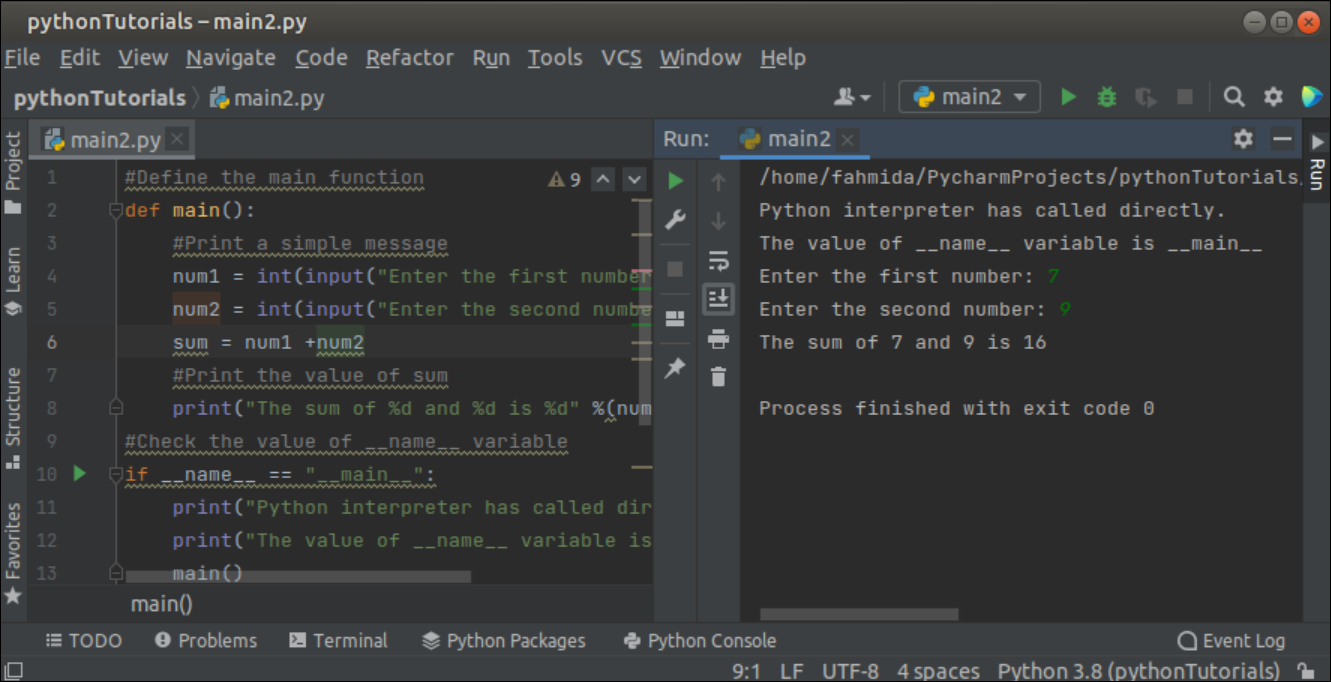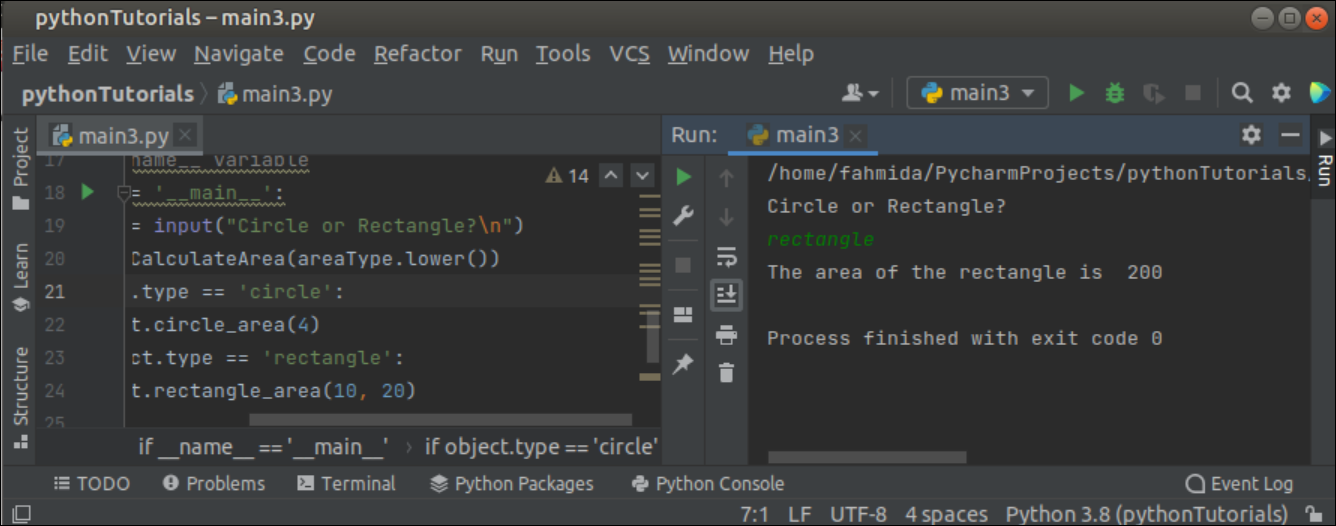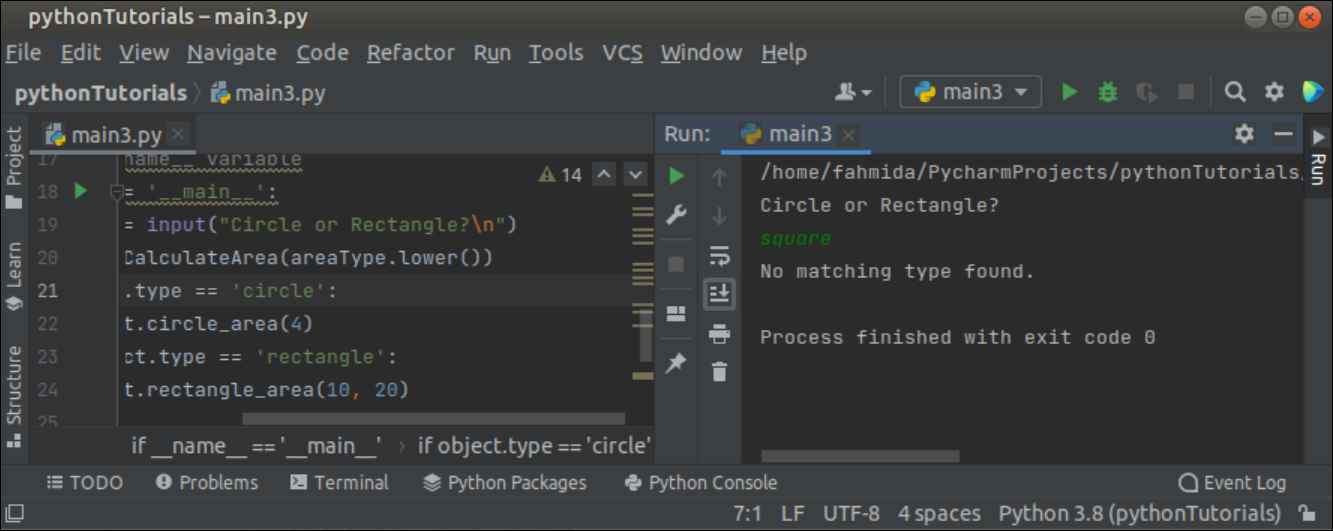Example-1: Simple Use of the __name__ Variable
Create a Python file with the following script that calls the main() function if the value of the __name__ variable is __main__. The main() function has been declared in the script to define the statements. A string value and a number value will be printed after calling the main() function. No module has been imported into the script. So, the ‘if’ statement will be returned True and the main() function will be called.
def main():
#Print a simple message
print("Testing the use of __name__ variable.")
#Initialize the variable with the number
n = 15
#Print the value of the variable
print("The value of n is ", n)
#Check the value of __name__
if __name__ == "__main__" :
#Call the main() function
main()
Output:
The following output will appear after executing the above script. The output shows that the ‘if’ condition has returned True and the main() function has been called.
Example-2: Print the Value of the __name__ Variable
Create a Python file with the following script that calls the main() function if the value of the __name__ variable is __main__, like the previous example. Two number values will be taken from the user and print the sum of the numbers after calling the main() function. The ‘if’ condition will check the value of the __name__ variable. If the condition returns True, then a message will be printed, the value of the __name__ variable will be printed, and the main function will be called. If the condition returns False, then a message will be printed and the value of the __name__ variable will be printed.
def main():
#Print a simple message
num1 = int(input("Enter the first number: "))
num2 = int(input("Enter the second number: "))
sum = num1 +num2
#Print the value of sum
print("The sum of %d and %d is %d" %(num1, num2, sum))
#Check the value of __name__ variable
if __name__ == "__main__":
print("Python interpreter has called directly.")
print("The value of __name__ variable is "+__name__)
main()
else:
print("Python interpreter has not called directly.")
print("Value of __name__ attribute is "+__name__)
Output:
The following output will appear after executing the above script. The output shows that the main() function has been called because the value of the __name__ variable is __main__. 7 and 9 have been taken as input from the user and the sum of 7 and 9 which is 16, has been printed in the output.
Example-3: Use of the __name__ Variable with Class
Create a Python file with the following script that defines a class to calculate the area of the circle and the rectangle. If the value of the __name__ variable is __main__, then the input will be taken from the user. Next, the object of the class will be created. The circle_area() method will be called if the input value is ‘circle’. The rectangle_area() method will be called if the input value is ‘rectangle’. A message will be printed if the input value does not match with the ‘circle’ or ‘rectangle’.
class CalculateArea:
#Declare constructor
def __init__(self, type):
self.type = type
#Declare method for calculating circle area
def circle_area(self, radius):
self.radius = radius
area = 3.14 * self.radius * self.radius
print("The area of the circle is ", area)
#Declare method for calculating rectangle area
def rectangle_area(self, h, w):
self.height = h
self.width = w
area = self.height * self.width
print("The area of the rectangle is ", area)
#Check the __name__ variable
if __name__ == '__main__':
areaType = input("Circle or Rectangle?\n")
object = CalculateArea(areaType.lower())
if object.type == 'circle':
object.circle_area(4)
elif object.type == 'rectangle':
object.rectangle_area(10, 20)
else:
print("No matching type found.")
Output:
The following output will appear after executing the above script. In the following output, the ‘circle’ has been taken as the input value and the area of the circle of radius 4 has been printed in the output.
In the following output, the ‘rectangle’ has been taken as the input value and the area of the rectangle (the height value, 10 and the width value, 20) has been printed in the output.
In the following output, the ‘square’ has been taken as an input value that does not match with ‘circle’ or ‘rectangle’.
Example-4: Use of the __name__ Variable After Importing a Module
Create a Python file named file1.py with the following script that will be imported into another Python file. This script will print a simple message, and a message based on the __name__ variable.
# Python file one module
#Print a simple message
print("Message from file1.py")
#Print the value of __name__ variable
print("The value of __name__ is ", __name__)
if __name__ == "__main__":
print("Python interpreter has called directly.")
else:
print("Python interpreter has not called directly.")
Create another Python file with the following script that will import the file1.py as a module in the script. This script will print a simple message, and a message based on the __name__ variable after importing the file1 module.
import file1
#Print a simple message
print("Welcome to LinuxHint")
#Print the value of __name__ variable
print("The value of __name__ is ", __name__)
if __name__ == "__main__":
print("Python interpreter has called directly.")
else:
print("Python interpreter has not called directly.")
Output:
The following output will appear after executing the above script. The output shows that the value of the __name__ variable is changed to the module name after importing another module in the script.
Conclusion
The purpose of using the __name__ variable has been explained in this tutorial by using different types of examples to help the users to use it in their script properly.






